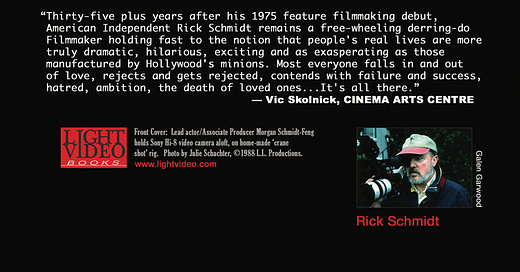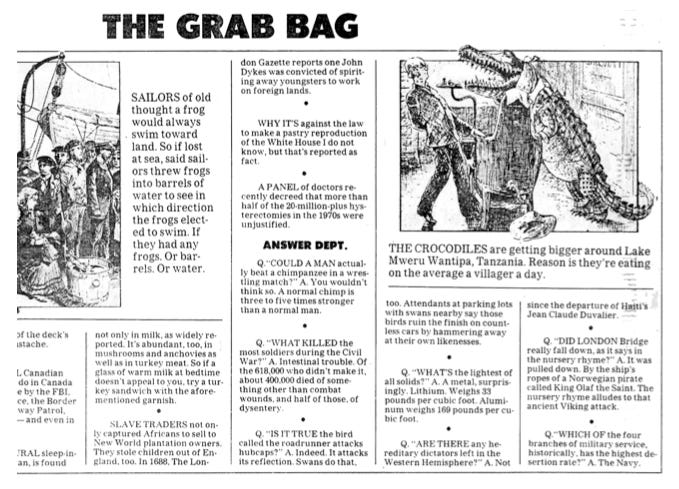HERE'S the big "AHA" moment for my MORGAN'S CAKE movie (where and how the "cake" part of the title originated). Still amazed that this connective & great idea crashed into me!
See full movie: https://vimeo.com/168153085
(Excerpted from THE MIRACLE OF MORGAN'S CAKE––Production Secrets of a $15,000 IMPROV Sundance Feature").
(Continuing the Morgan’s Cake CASE-STUDY (NEXT STEPS after videotaping a man on the street in Berkeley…).
Yes, I had snagged a very interesting segment of some movie, but what could be the core of “Morgan,” I wondered? And the question of budget continued to plague me. Where would I get the $15,000+ needed for such a 16mm enterprise? At that time, in 1986, it was hard to imagine that a movie shot completely in video could be considered a serious project, so although I fleetingly considered that option, I held out for film or nothing. The man-on-the-street video I had recorded was technically faulty, with its sunspots, grainy texture and movement blurs. But because of the intensity and drama it contained (and the short duration it might be on-screen), I believed it was usable. For regular scenes, though, real takes that ran more than twenty seconds, I couldn’t imagine that the Hi-8, low-level video would be tolerable for an audience. It was nowhere near the resolution of Mini-DV. So I was stuck without a solid script and lacking the necessary moviemaking funds.
At junctures like this in my life, where moviemaking concepts begin taking over my thoughts, it feels like I have a moviemaking antenna, something of a sixth sense, where I pay closer attention to everything that crosses my path. It’s as if my subconscious mind is searching for that clues that I desperately need. It was because of this ongoing transformation, drifting from regular person to moviemaker, that I noticed the missing key to my Morgan movie while I was perusing the San Francisco Chronicle newspaper one day.
As I scanned a section called “Grab Bag” I was suddenly struck by one of the items. It said, “While it can not be confirmed as fact, it is believed that it is illegal to make a pastry reproduction of the White House.” The part of my brain that was taken over by moviemaking suddenly went ballistic. My God! Is this for real? Am I seeing things?In real life, Morgan was in a countdown to his actual 18th birthday, the date by which he’d have to decide about registering or not for the draft. The climax of that stretch of time, the ending for our movie, would be...HIS BIRTHDAY! Birthday = birthday party = birthday CAKE. Could the Grab Bag article be offering...THE KEY! Morgan could demonstrate his conscious objection to the draft by...baking a cake! A WHITE HOUSE CAKE!
It was an amazing feeling, like hitting a 20-1 jackpot in Vegas or something equally pie-in-the-sky. The sun seemed suddenly to be shining brighter (impossible, given the fully- overcast Bay Area skies). Morgan could have his cake, and he could...eat it too! I thought, laughing. Suddenly I had a movie to make – Morgan’s Cake!
‘Cake’ Pre-Production Problem-Solving
After the Grab Bag breakthrough, I started writing down scenes and creating dialogue between Morgan and Leon (working off the videotaped dialogue from the Berkeley hilltop shoot), as well as trolling for investment to make the film.
The breakthrough, ‘funding-wise,’ finally came through when overhearing a conversation at a party about conscientious objectors. I made a connection with a San Francisco patron of the arts in conversation there dedicated to that cause, who agreed to supply the first $5000 I needed to get my Morgan “anti-draft” movie off the ground. With $5000 in hand to shoot, I told myself I’d would worry about the finishing funds later!
Continuing on with the creative side, I tried to imagine situations between Morgan and “his father,” but it was hard to get started. There were some big blank spots. Where did they live? What was the central location where most of the action would take place? For a while I considered shooting in my flat in Point Richmond, California, but finally realized that it wouldn’t work with a toddler around (my new son Marlon was then just one-and-a-half years old).
And who would play Morgan’s father? Or his mother? I didn’t want to have to re- write everything once I actually gained access to locations and cast people to act the parts. So, at the very start of the scripting process, my antenna was seriously scanning for these needed items. So location scouting and casting became intermixed with scripting.
One morning, as I was approaching Jumbo’s, the local breakfast cafe, I spotted a “For Rent” sign in a window directly above the entrance. I immediately ascended the wide staircase of the turn-of-the-century building and walked over to the door. It was locked. I knocked. Nothing. I knocked at another door and was shyly greeted by a woman with a wet paint brush in her hand. She had her own little cubbyhole art studio up there on the 2nd floor and was painting a picture on a large, stretched canvas that barely fit her widest wall. She told me the landlord’s phone number, and I let her get back to work. Of course, my moviemaking antenna noted her as a possible actor for Morgan’s Cake, her painting studio a fascinating set (she’s in the final movie).
Eventually I ended up renting the little one-room office space for $100 a month, and turned it into my grand “production office.” Oh yes, I was suddenly in business! Given that I needed a location to shoot in, someplace that was in my immediate control, the office space was ideal. The next question became, What is the connection between Morgan, his activities as a teenager, and that small, 9' by 12' office space above Jumbo’s Restaurant?
After spending some time in the tiny office, cleaning it up, looking out the window, wandering around the upper hallway, eating meals at Jumbo’s downstairs, I figured out that Morgan lived in that office. He lived there, even slept there, with his father. Yes, it was very tight, but his father could sleep on top of the desk (a garage sale find that I had installed against a side wall). Although the desk was too short for any normal-sized adult male to lie on, I realized that I could extend its length another foot by pushing a bookcase up against it, raising its level up three inches to match the desk's height (I soon found the needed bookcase prop at another garage sale). OK. So dad slept on top of his desk. And Morgan? Teenager Morgan would sleep on the floor, in a sleeping bag, like on a continual sleep-over. One proposition led to another. That’s why you don’t have to know everything when you're scripting or improvising. All you have to do is keep solving the problems as they arise. That’s how a movie (or script) gets built.
Soon I had vital new information to pour into my script. The Morgan character lived with his divorced father (no stretch for the real Morgan, since I’d been divorced from his mother since he was a child). And I figured out that his father worked downstairs at Jumbo’s restaurant So I asked the owner/chef of Jumbo’s if I could bring in an actor to do a scene, as if he were her kitchen help. Fortunately she agreed. And she acted as well, speaking several lines for the movie as she stood cooking over the grill.
Who would play Morgan’s father? Suddenly I remembered helping my actor/writer/director friend, Willie Boy Walker audio-record his story about acting crazy at the Oakland, California induction center to avoid going to Vietnam when he was drafted. (watch him in MORGAN’S CAKE TRAILER). With his great draft-dodge story he was perfect to play Morgan’s parent. I called him up and he agreed, adding that he needed pay – $500 for this leading role – and a promise. Just don’t try to direct me, OK? I don’t like direction. Oh. OK. Fine. Whatever. When you work with old friends you need to be prepared to lose some control. Willie, of course, did ultimately follow my leads, while delivering his brilliant performance.
So, by the seemingly simple gesture of renting an office space, my movie began to write itself. And while I scripted the opening scenes, seated there in the very setting where scenes would take place, I could soak in the ambience, work unhurried to “dress the set,” puttering around to get things in shape for the shoot. I connected the bookcase to the desk-bed, moved in Morgan's surfboard and sleeping bag, other personal items, placed some of Willie’s paintings on the walls to give it a lived-in appearance. Other decisions, like considering curtains or shades for the window (decided against either), and chatting with the woman artist across the hall, kept the bare-bones story moving ahead.
This kind of pre-production flow, where little bits and pieces of a movie slowly come together and coalesce, is probably the same type of moviemaking process you’ll experience when you try to make a movie with DV equipment. The trick is to not get scared or discouraged at the early stages, when nothing is coming together and all you’ve got is a hunch about a movie idea.
WATCH (FREE!)— Morgan’s Cake (87 min. ©1987) Here.
————






"... drifting from regular person to moviemaker,..." A "regular person" mostly HOPES it's going to happen. When an awakening occurs, for whatever reason, and now you KNOW you're a Moviemaker, you also KNOW: It WILL happen. It's impossible to overstate the essential, indispensable, irreplaceable nature of that KNOWING. (I believe you can replace the word "moviemaker" with WHATEVER IT IS for you, uniquely, personally, that you want to BE. ... I just get a little annoyed when I think how late in life it is that I've awakened to this. :-) Time's a'wastin'.)